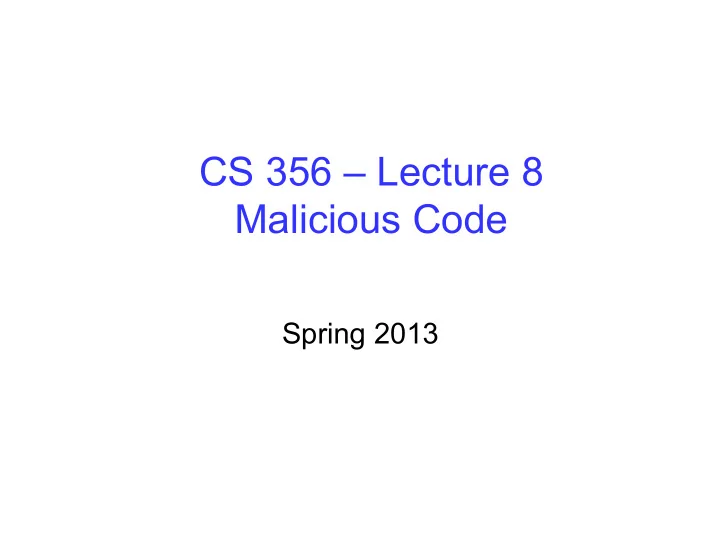

CS 356 – Lecture 8 Malicious Code Spring 2013
Review • Chapter 1: Basic Concepts and Terminology – Integrity, Confidentiality, Availability, Authentication, and Accountability – Types of threats: active vs. passive, insider/outsider • Chapter 2: Basic Cryptographic Tools – Symmetric key encryption and secure hashing – Public key cryptography and Random Numbers • Chapter 3 – User Authentication – Passwords, Checking passwords and Biometrics • Chapter 4 – Access Control Lists – Concepts and Discretionary Access Control – Role Based Access Control (RBAC) • Chapter 5 – Database Security (skipped) • Chapter 6 – Malicious Software
Chapter 6 Malicious Software
Malware [NIST05] defines malware as: “a program that is inserted into a system, usually covertly, with the intent of compromising the confidentiality, integrity, or availability of the victim’s data, applications, or operating system or otherwise annoying or disrupting the victim.”
Malware Terminology
Classification of Malware classified into two also classified by: broad categories: based first on how it spreads those that need a host or propagates to reach the program (parasitic code such desired targets as viruses) then on the actions or those that are independent, payloads it performs once a self-contained programs target is reached (worms, trojans, and bots) malware that does not replicate (trojans and spam e- mail) malware that does replicate (viruses and worms)
Types of Malicious Software (Malware) propagation mechanisms include: • infection of existing content by viruses that is subsequently spread to other systems • exploit of software vulnerabilities by worms or drive-by- downloads to allow the malware to replicate • social engineering attacks that convince users to bypass security mechanisms to install Trojans or to respond to phishing attacks payload actions performed by malware once it reaches a target system can include: • corruption of system or data files • theft of service/make the system a zombie agent of attack as part of a botnet • theft of information from the system/keylogging • stealthing/hiding its presence on the system
Viruses • piece of software that infects programs – modifies them to include a copy of the virus – replicates and goes on to infect other content – easily spread through network environments • when attached to an executable program a virus can do anything that the program is permitted to do – executes secretly when the host program is run • specific to operating system and hardware – takes advantage of their details and weaknesses
Virus Components infection mechanism • means by which a virus spreads or propagates • also referred to as the infection vector trigger • event or condition that determines when the payload is activated or delivered • sometimes known as a logic bomb payload • what the virus does (besides spreading) • may involve damage or benign but noticeable activity
Virus Phases triggering phase dormant phase • virus is activated • virus is idle to perform the • will eventually be function for which activated by it was intended some event • can be caused by • not all viruses a variety of have this stage system events propagation phase execution phase • virus places a copy of itself into • function is other programs or into certain performed system areas on the disk • may be harmless • may not be identical to the or damaging propagating version • each infected program will now contain a clone of the virus which will itself enter a propagation phase
Virus Structure
Compression Virus Logic
Compression Operation
Virus Classifications classification by classification by target concealment strategy • boot sector infector • encrypted virus – infects a master boot record or – a portion of the virus creates a boot record and spreads when random encryption key and a system is booted from the encrypts the remainder of the disk containing the virus virus • file infector • stealth virus – infects files that the operating – a form of virus explicitly designed system or shell considers to be to hide itself from detection by executable anti-virus software • polymorphic virus • macro virus – a virus that mutates with every – infects files with macro or infection scripting code that is • metamorphic virus interpreted by an application – a virus that mutates and rewrites • multipartite virus itself completely at each iteration – infects files in multiple ways and may change behavior as well as appearance
Macro/Scripting Code Viruses • very common in mid-1990s – platform independent – infect documents (not executable portions of code) – easily spread • exploit macro capability of MS Office applications – more recent releases of products include protection • various anti-virus programs have been developed so these are no longer the predominant virus threat
What ’ s Next • Read Chapter 1, 2, 3, 4, (skip 5), and 6 – Chap 1: Focus on big picture and recurring concepts – Chap 2: Identify cryptographic tools and properties – Chap 3: How can you authenticate a user? – Chap 4: Access Control – Chap 6: Intrusion Detection • Homework Posted on Course Website – Due Tuesday • Project 1 Due Thursday • Next Lecture Topics From Chapter 6 – Worms, Bots, and Malware
Recommend
More recommend